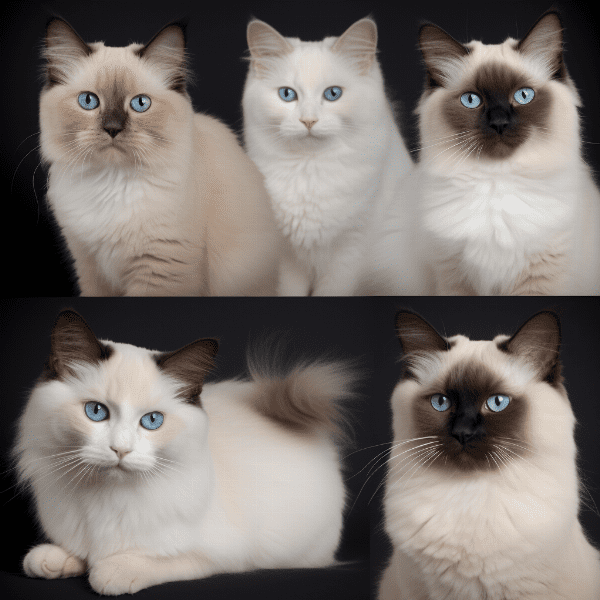Table of Contents
- Understanding the Importance of Cat Grooming
- Preparing the Tools and Environment for Trimming
- Holding Your Cat in a Comfortable Position
- Trimming Techniques for a Shaved Cat Tail
- Handling Accidents or Injuries during the Process
- Post-Trimming Care and Rewards for Your Cat
- Scheduling Regular Cat Grooming Sessions
- Common Mistakes to Avoid while Trimming a Cat’s Tail
- Seeking Professional Help for Difficult Cases
- Conclusion and Recap of Key Tips for Safe Trimming
Understanding the Importance of Cat Grooming
Keeping your feline friend clean and healthy is one of the most essential tasks you can do as a cat owner. Grooming is a crucial aspect of maintaining a cat’s physical and emotional well-being. In this section, we will discuss why grooming is so important and the benefits it provides for your pet.
Detects Health Issues Early On
Grooming is not only for the sake of aesthetics but also for your cat’s health. Regular grooming sessions give you a chance to examine your cat’s body for any lumps, bumps, or abnormalities that may indicate health issues. Catching health issues early on can be crucial in preventing them from developing into serious illnesses.
Reduces Stress and Anxiety
Cats are naturally fastidious animals, and they can become stressed and anxious if their coat is dirty or matted. Regular grooming helps to reduce stress and anxiety in your pet by providing them with a clean and comfortable environment. Grooming also helps to stimulate circulation and provide your cat with a sense of relaxation and well-being.
Conclusion
Grooming your cat regularly is essential to maintain their physical and emotional well-being. It promotes good health and hygiene, helps detect health issues early on, improves bonding and socialization, and reduces stress and anxiety. In the following sections, we will discuss the steps you can take to groom your cat safely and effectively.
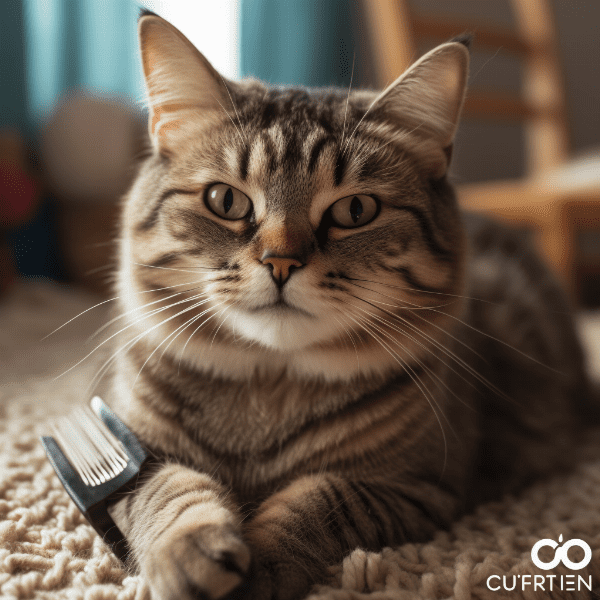
Preparing the Tools and Environment for Trimming
Before you begin trimming your cat’s shaved tail, it is essential to prepare the necessary tools and create a suitable environment to ensure your pet’s safety and comfort. In this section, we will discuss the tools you will need and the steps you can take to create a suitable grooming environment.
Gather the Necessary Tools
The first step in preparing for trimming is to gather the necessary tools. You will need a pair of small, sharp scissors or clippers, a comb, and a styptic powder or cornstarch in case of bleeding. It is essential to use sharp tools to avoid causing discomfort or injury to your cat.
Choose a Suitable Environment
Next, choose a suitable environment for trimming. It is best to choose a quiet, well-lit room with a non-slip surface, such as a table or countertop. Make sure the room is free of any potential hazards that could cause injury to your cat, such as sharp objects or loose items that could be knocked over.
Calm and Comfort Your Cat
Before beginning the trimming process, take some time to calm and comfort your cat. Talk to your cat in a gentle and reassuring tone to help them relax. You can also offer treats or toys to distract them and make the grooming experience more enjoyable.
Secure Your Cat
When trimming a cat’s tail, it is important to ensure that they are comfortable and secure. You can use a towel or blanket to wrap your cat and prevent them from moving around. Alternatively, you can ask a friend or family member to assist you by holding your cat still.
Conclusion
Preparing the tools and environment for trimming is crucial to ensure your cat’s safety and comfort during the grooming process. Gathering the necessary tools, choosing a suitable environment, calming and comforting your cat, and securing them are all essential steps to take before beginning the trimming process. In the next section, we will discuss the proper techniques for holding your cat during trimming.
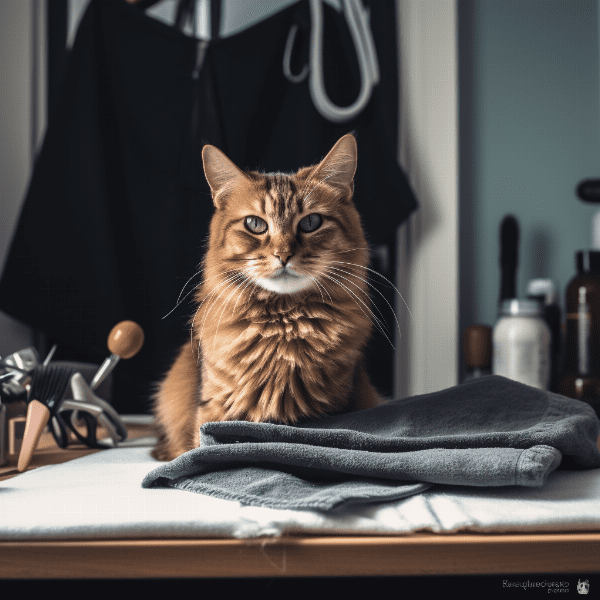
Holding Your Cat in a Comfortable Position
The Scruffing Technique
One of the most effective ways to hold a cat during trimming is the scruffing technique. This involves gently grasping the loose skin on the back of your cat’s neck and lifting them slightly. This technique mimics the way a mother cat carries her kittens, making your cat feel secure and comfortable.
The Burrito Technique
The burrito technique is another effective way to hold your cat during trimming. This technique involves wrapping your cat in a towel or blanket, leaving only their tail exposed. This technique can be especially useful for cats that are very active or anxious during grooming sessions.
The Assistance of a Friend or Family Member
If you have trouble holding your cat on your own, you can ask a friend or family member to assist you. One person can hold the cat while the other trims the tail. This can be especially helpful for cats that are very large or difficult to handle.
Comforting Your Cat
No matter which technique you choose, it is essential to make your cat feel comfortable and secure during the trimming process. Speak to your cat in a calm and soothing voice, and offer treats or toys to help distract them. You can also take breaks if your cat becomes agitated or stressed.
Conclusion
Holding your cat in a comfortable position is essential for a safe and successful trimming session. The scruffing technique, the burrito technique, and the assistance of a friend or family member are all effective ways to hold your cat during trimming. Remember to make your cat feel comfortable and secure throughout the grooming process. In the next section, we will discuss the proper techniques for trimming a Shaved cat tail.
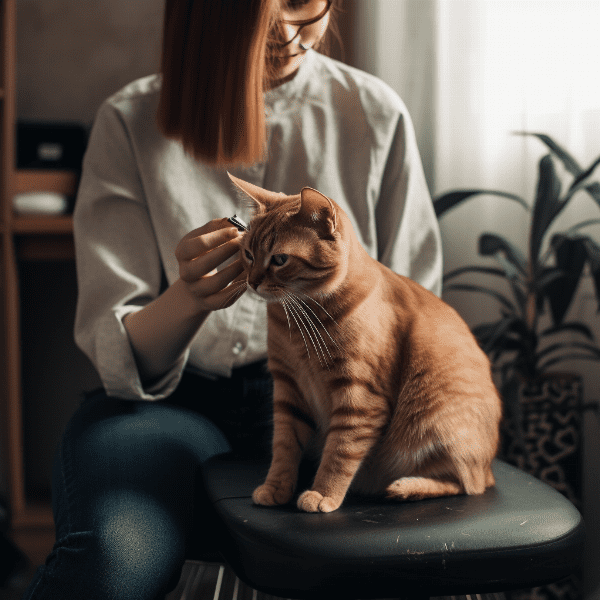
Trimming Techniques for a Shaved Cat Tail
Trimming a shaved cat tail requires a steady hand and a careful approach to avoid injuring your pet. In this section, we will discuss the proper techniques for trimming a shaved cat tail safely and effectively.
Start Slowly
When trimming a shaved cat tail, it is essential to start slowly and carefully. Begin by brushing the tail to remove any tangles or mats. Then, using sharp scissors or clippers, trim the fur around the tail in small sections, taking care not to cut too close to the skin.
Follow the Natural Shape of the Tail
When trimming your cat’s tail, it is important to follow the natural shape of the tail. Do not try to cut the tail into a specific shape or length, as this can be uncomfortable for your pet and may cause injury.
Avoid Cutting the Skin
One of the most important things to remember when trimming a cat’s tail is to avoid cutting the skin. Take care to keep the scissors or clippers away from the skin and only trim the fur. If you do accidentally cut the skin, use styptic powder or cornstarch to stop the bleeding.
Take Breaks as Needed
If your cat becomes agitated or stressed during the trimming process, take breaks as needed. Offer treats or toys to help distract your cat, and speak to them in a calm and reassuring tone. Resume trimming when your cat is calm and comfortable.
Reward Your Cat
After trimming your cat’s tail, be sure to reward them with treats or affection. This will help reinforce positive behavior and make grooming sessions more enjoyable for your pet.
Conclusion
Trimming a shaved cat tail requires a careful and steady approach to ensure your pet’s safety and comfort. Start slowly, follow the natural shape of the tail, avoid cutting the skin, take breaks as needed, and reward your cat afterward. In the next section, we will discuss how to handle accidents or injuries that may occur during the trimming process.
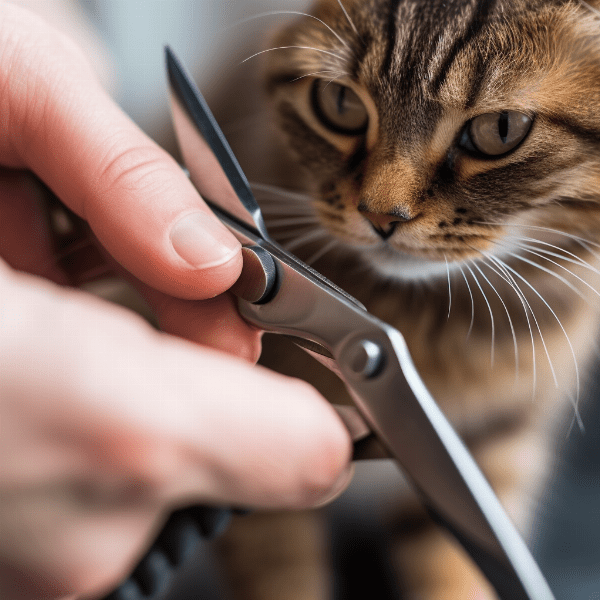
Handling Accidents or Injuries during the Process
Despite your best efforts, accidents or injuries can still occur during the trimming process. It is important to know how to handle these situations to ensure your cat’s safety and well-being. In this section, we will discuss the steps you can take if an accident or injury occurs during the trimming process.
Stay Calm
If an accident or injury occurs, it is important to stay calm. Cats can sense your emotions and may become more anxious or agitated if you are upset or nervous. Take a deep breath, speak to your cat in a calm and soothing voice, and assess the situation.
Apply Pressure to Stop Bleeding
If you accidentally cut your cat’s skin, apply pressure to the area to stop the bleeding. Use a clean cloth or gauze pad to apply pressure for a few minutes. If the bleeding does not stop, contact your veterinarian for further advice.
Clean the Wound
Once the bleeding has stopped, clean the wound with warm water and a mild soap. Gently pat the area dry with a clean towel or cloth.
Apply an Antiseptic
Apply an antiseptic cream or spray to the wound to prevent infection. Be sure to use a product that is safe for cats and follow the instructions carefully.
Seek Veterinary Care
If the wound is severe or does not appear to be healing, seek veterinary care immediately. Your veterinarian can provide further treatment and advice to ensure your cat’s well-being.
Conclusion
Accidents or injuries can occur during the trimming process, but knowing how to handle these situations can help ensure your cat’s safety and well-being. Stay calm, apply pressure to stop bleeding, clean the wound, apply an antiseptic, and seek veterinary care if needed. In the next section, we will discuss post-trimming care and rewards for your cat.
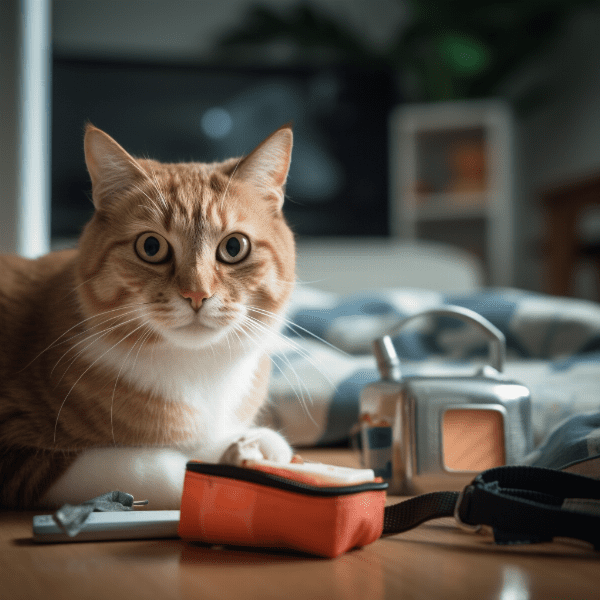
Post-Trimming Care and Rewards for Your Cat
After trimming your cat’s tail, it is essential to provide post-trimming care to ensure their comfort and well-being. In this section, we will discuss the steps you can take to care for your cat after trimming and the rewards you can offer to make the experience more enjoyable.
Brush the Tail
After trimming your cat’s tail, use a soft brush to remove any loose fur or tangles. This will help keep your cat’s coat smooth and healthy and prevent hairballs.
Check for Irritation or Discomfort
Check your cat’s tail for any signs of irritation or discomfort. If your cat appears to be in pain or is licking or scratching the tail excessively, contact your veterinarian for advice.
Offer Treats or Affection
Offer treats or affection to your cat after trimming to help reinforce positive behavior and make the experience more enjoyable. This will also help your cat associate grooming sessions with positive experiences.
Provide a Comfortable Environment
Provide a comfortable environment for your cat after trimming. Make sure they have access to water, food, and a comfortable bed or resting area. Keep the room quiet and free from any potential hazards.
Schedule Regular Grooming Sessions
To maintain your cat’s health and well-being, schedule regular grooming sessions. This will help prevent tangles and mats, reduce the risk of skin infections, and keep your cat’s coat healthy and shiny.
Conclusion
Post-trimming care is essential to ensure your cat’s comfort and well-being. Brush the tail, check for irritation or discomfort, offer treats or affection, provide a comfortable environment, and schedule regular grooming sessions. By following these steps, you can help make grooming sessions a positive and enjoyable experience for both you and your cat.

Scheduling Regular Cat Grooming Sessions
Regular grooming sessions are crucial to maintain your cat’s physical and emotional well-being. In this section, we will discuss the importance of scheduling regular grooming sessions and the benefits they provide for your pet.
Prevents Tangles and Mats
Regular grooming sessions help prevent tangles and mats, which can be painful and uncomfortable for your cat. Brushing your cat’s fur removes loose hair and prevents it from becoming matted, keeping your cat’s coat healthy and shiny.
Reduces the Risk of Skin Infections
Regular grooming sessions also help to reduce the risk of skin infections. Brushing and combing your cat’s fur removes dirt and debris that can lead to skin irritations and infections. Regular grooming can also help detect any lumps or bumps on your cat’s skin, allowing you to seek veterinary care early on.
Strengthens Bonding and Socialization
Regular grooming sessions offer an excellent opportunity for you to bond with your cat. Cats enjoy the attention and affection they receive during grooming sessions and may even purr or knead in response. Grooming can be a relaxing and enjoyable experience for both you and your pet and can help to strengthen your relationship with your cat.
Promotes Good Health and Hygiene
Regular grooming sessions promote good health and hygiene by keeping your cat’s coat clean and free of tangles and mats. Grooming also helps to prevent hairballs, a common problem for many cats, and reduces the risk of skin infections.
Conclusion
Scheduling regular grooming sessions is crucial to maintaining your cat’s physical and emotional well-being. Regular grooming helps prevent tangles and mats, reduces the risk of skin infections, strengthens bonding and socialization, and promotes good health and hygiene. By following a regular grooming schedule, you can help ensure your cat’s long-term health and happiness.
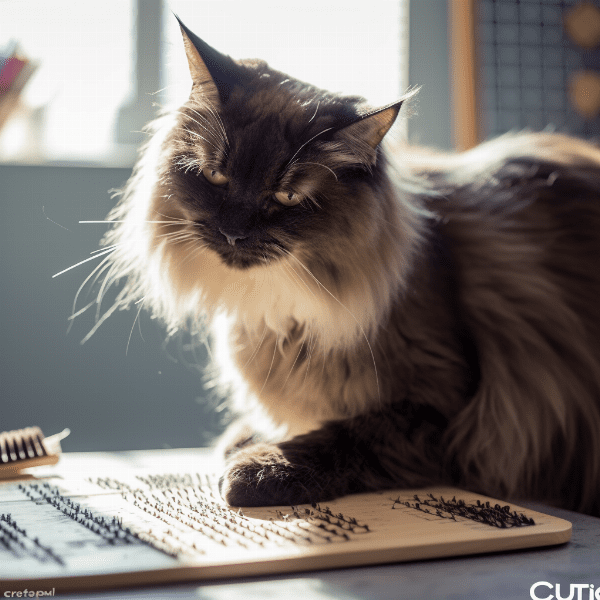
Common Mistakes to Avoid while Trimming a Cat’s Tail
Trimming a cat’s tail can be a challenging task, especially if you are inexperienced or unsure of what to do. In this section, we will discuss some common mistakes to avoid while trimming a cat’s tail to ensure your pet’s safety and well-being.
Using Dull Scissors or Clippers
One of the most common mistakes when trimming a cat’s tail is using dull scissors or clippers. Dull tools can cause discomfort and pain for your cat and can also make the trimming process more challenging. Always use sharp scissors or clippers to ensure a smooth and safe trimming experience.
Cutting Too Close to the Skin
Cutting too close to the skin can cause discomfort, pain, and even injury to your cat. When trimming your cat’s tail, be sure to keep the scissors or clippers away from the skin and only trim the fur. This will help prevent injury and ensure your cat’s comfort.
Trimming Too Much at Once
Trimming too much fur at once can be overwhelming for your cat and may cause stress and discomfort. Instead, trim small sections of fur at a time, taking breaks as needed to ensure your cat’s comfort and well-being.
Not Holding Your Cat Properly
Holding your cat in a comfortable and secure position is crucial to a successful trimming session. If your cat is uncomfortable or agitated, they may try to escape or move around, making it difficult to trim their tail safely. Use the proper holding techniques discussed earlier in this guide to ensure your cat’s safety and comfort.
Conclusion
Avoiding common mistakes while trimming your cat’s tail is essential to ensure your pet’s safety and well-being. Always use sharp scissors or clippers, avoid cutting too close to the skin, trim small sections at a time, and hold your cat in a comfortable and secure position. By following these tips, you can help make the trimming process a safe and positive experience for both you and your cat.
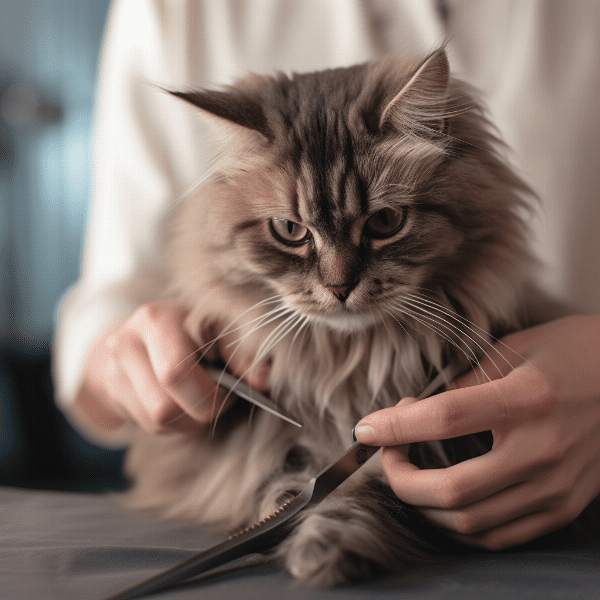
Seeking Professional Help for Difficult Cases
In some cases, trimming a cat’s tail may be too challenging or dangerous to do on your own. If you are inexperienced or unsure of what to do, or if your cat is particularly difficult or aggressive during grooming sessions, seeking professional help may be the best option. In this section, we will discuss when to seek professional help and the benefits of doing so.
Signs You Should Seek Professional Help
If you are unsure of how to trim your cat’s tail or if your cat is exhibiting signs of stress or discomfort during grooming sessions, it may be time to seek professional help. Additionally, if your cat has a medical condition that affects their tail, such as an injury or infection, seeking veterinary care may be necessary.
Benefits of Professional Help
Professional groomers and veterinarians have the experience, knowledge, and tools necessary to trim a cat’s tail safely and effectively. They can also provide advice and guidance on grooming techniques and post-grooming care to ensure your cat’s well-being.
Conclusion
Trimming a cat’s tail can be a challenging task, especially for inexperienced pet owners. If you are unsure of how to trim your cat’s tail or if your cat is exhibiting signs of stress or discomfort, seeking professional help may be the best option. Professional groomers and veterinarians have the experience and knowledge necessary to trim your cat’s tail safely and effectively, ensuring your pet’s well-being.
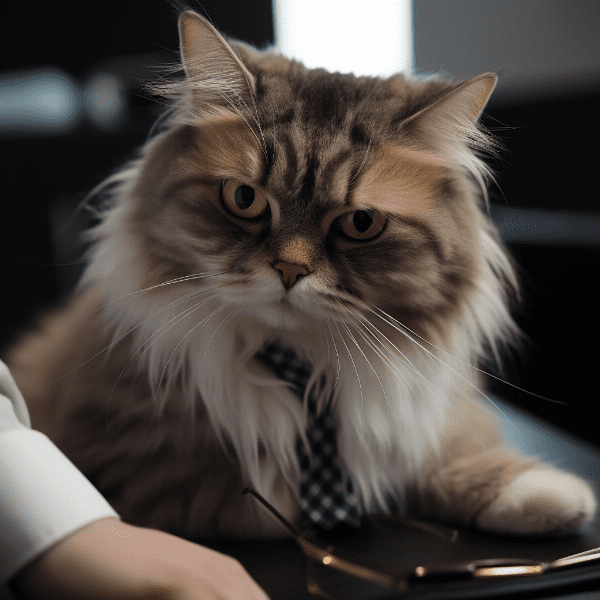
Conclusion and Recap of Key Tips for Safe Trimming
Trimming a cat’s tail requires a careful and steady approach to ensure your pet’s safety and comfort. By following the tips and techniques discussed in this guide, you can help make the trimming process a positive and enjoyable experience for both you and your cat.
- Understand the importance of cat grooming and the benefits of regular grooming sessions.
- Prepare the tools and environment for trimming to ensure your pet’s safety and comfort.
- Hold your cat in a comfortable and secure position during trimming.
- Use proper trimming techniques, such as starting slowly and following the natural shape of the tail, to avoid injury.
- Handle accidents or injuries that may occur during the trimming process by staying calm and seeking veterinary care if necessary.
- Provide post-trimming care and rewards to ensure your cat’s comfort and well-being.
- Avoid common mistakes such as using dull scissors or clippers, cutting too close to the skin, trimming too much at once, and not holding your cat properly.
- Seek professional help if necessary.
By following these key tips, you can help ensure your cat’s safety and well-being during the trimming process. Remember to always approach grooming sessions with patience and care, and to seek professional help if you are unsure or if your cat requires veterinary attention.


